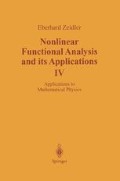Abstract
In this chapter we consider a plate which is clamped at the boundary. Our method of proof, however, can also be applied to other boundary conditions. We use the following tools:
-
(I)
Implicit function theorem (Theorem 4.B).
-
(P)
Main theorem about pseudomonotone operators (Theorem 27.A).
-
(B)
Main theorem of bifurcation theory for potential operators (Theorem 45.A).
The historical development of nonlinear plate and shell theories has not been as felicitous as that of rod theories up to the creation of Kirchhoff’s theory. Kirchhoff (1824–1887) established a satisfactory linear theory of plates begun by Navier (1785–1836). A popular nonlinear plate theory was finally developed by von Kármán in 1910.
These equations are “derived” by introducing, in the standard procedure of mechanics, a number of geometric approximations that are roughly analogous to the replacement of sin φ in the rod equation
\(\varphi" \, + Sin\,\varphi \, = \,0\)
by its cubic approximation φ − φ 3/6. Moreover, the von Kármán’s equations are based upon a certain linear stress-strain law.
Stuart Antman (1977)
The number of papers about plates is infinitely large, and gets larger and larger.
Mathematical folclore
Access this chapter
Tax calculation will be finalised at checkout
Purchases are for personal use only
Preview
Unable to display preview. Download preview PDF.
References to the Literature
Classical works: von Kármán (1910), Friedrichs and Stoker (1942) (nonlinear circular plates), Berger and Fife (1967).
Explicit computations: Dickey (1976, L).
Introduction: Vlasov (1964, M) and Pflüger (1965, M) (shells), Szillard (1974, M) (plates).
Modern introduction: Ciarlet and Rabier (1980, L), Djubek, Kodhár, and Škaloud (1983, M) (existence and numerical methods).
Handbook article about plates and shells: Naghdi (1972, B).
Existence theory: Vorovic (1955), Berger and Fife (1967), Langenbach (1976, M), Ciarlet and Rabier (1980, L), Necas and Hlavácek (1981, M).
Bifurcation for plates, imperfections, and catastrophe theory: Chow, Hale, and Mallet-Paret (1975), Chow and Hale (1982, M).
Bifurcation for rectangular plates: Knightly and Sather (1974), List (1978), Recke (1978), Chow and Hale (1982, M) (recommended as an introduction).
Bifurcation for circular plates: Dickey (1976, L), Antman (1980) (global branches).
Bifurcation for shells: Sather (1976, S), Recke (1978), Knightly and Sather (1980).
Cones and positive eigensolutions for the plate equation: Miersemann (1979).
Buckling of plates with obstacles: Do (1975), (1977), Miersemann (1975), (1981, S), (1982).
Control of the stability of plates: Beckert (1972), Hofmann (1986) (general theory for the control of the smallest eigenvalue of self-adjoint compact operator in H-spaces by using a constructive approach via subgradient methods).
Derivation of the von Kármán equations from three-dimensional elasticity via asymptotic expansions: Ciarlet and Rabier (1980, L).
Numerical methods: Ciarlet (1977, M), Brezzi (1978), Djubeck, Kodnâr, and Skaloud (1983, M), Bernadou and Boisserie (1982, M) (finite elements in thin shell theory).
A priori estimates for the stresses in shells and interior shell equations: John (1965), (1971), (1985, S) (fundamental papers).
Shells: Koiter (1972), (1980), Ramm (1982, M), Niordson (1985, M), Antman (1986).
Author information
Authors and Affiliations
Rights and permissions
Copyright information
© 1988 Springer Science+Business Media New York
About this chapter
Cite this chapter
Zeidler, E. (1988). Pseudomonotone Operators, Bifurcation, and the von Kármán Plate Equations. In: Nonlinear Functional Analysis and its Applications. Springer, New York, NY. https://doi.org/10.1007/978-1-4612-4566-7_9
Download citation
DOI: https://doi.org/10.1007/978-1-4612-4566-7_9
Publisher Name: Springer, New York, NY
Print ISBN: 978-1-4612-8926-5
Online ISBN: 978-1-4612-4566-7
eBook Packages: Springer Book Archive

